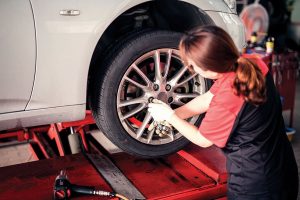To ensure a smooth and memorable journey, consider these planning tips before departing on your road trip adventure.
Set Your Destination
When planning a road trip, the first step is to decide your destination. Consider factors such as the distance you are willing to travel, time available for your trip and attractions or landmarks you want to visit along the way. Also factor in weather conditions and seasonality of your destination as some places may be more enjoyable to visit during certain times of year. Keep in mind any special events or festivals happening you might want to attend.
Determine a Budget
Determine how much you are willing to spend on gas, food, lodging and entertainment. This can help you make informed decisions and avoid overspending. For example, when budgeting for food, plan for a mix of dining out and cooking your own meals. Pack a cooler with snacks and drinks for the road and make use of local grocery stores or farmers markets to buy fresh ingredients.
Plan Your Route
Take some time to map out your journey using online tools or GPS devices, considering the most scenic and interesting routes available. Consider the duration of your trip and how many stops you want to make along the way, finding a balance between driving time and time spent exploring attractions or enjoying the scenery. Also identify any must-see landmarks along your route.
Research Accommodations
Research different accommodation options along your route, such as hotels, motels, campgrounds and vacation rentals. Compare prices, read reviews and consider factors like location, amenities and safety. To save money on accommodations, consider alternatives like camping or staying with friends or family.
Pack the Essentials
Packing for a road trip can be a challenge, but with the right essentials, you can ensure a comfortable and enjoyable journey. Start by making a list of the items you may need during the trip, including clothing, toiletries and any special equipment or gear. Don’t forget essentials like comfortable shoes, swimwear and a jacket or sweater.

Other important items to pack include a first aid kit, snacks and drinks for the road, phone chargers and entertainment options such as books, music or games. It’s also a good idea to pack basic tools and emergency supplies, such as a flashlight, jumper cables, spare tire and a roadside emergency kit.
Take Appropriate Safety Precautions
While road trips are exciting adventures, it’s important to prioritize safety to ensure a smooth and memorable journey. Before hitting the road, share your itinerary with someone you trust and make sure your vehicle is in good condition. Check the tires, brakes, fluids and lights to minimize the risk of breakdowns or accidents. Also plan regular rest stops to avoid driver fatigue and stay updated on weather conditions and road closures along your route.

Before you head out this summer, consider these tips from the tire experts at your neighborhood Discount Tire to stay safe on the road.
- Check Tire Pressure Regularly
Low tire pressure can lead to poor handling and gas mileage as well as excessive wear and overloading. Before any long trips – and at least once a month – check your tires’ air pressure, as bumps and turns can lead to air loss. Temperature changes also affect air pressure. For every 10 degrees in ambient temperature change, air pressure changes 1 pound per square inch (PSI).
- Be Tire Tread Aware
The amount of tread on a tire, or tread depth, determines safe stopping distance. The more tread on the tire, the better it can grip the road and stop in a shorter distance. To check tread depth yourself, stick a penny upside-down in a tread groove. If President Lincoln’s head is visible, your tires are worn beyond safe-level recommendations and it’s time to replace.
- Understand Tire Age Matters
As tires age, the rubber becomes harder and brittle, which can lead to higher risk for tire failure. Locate the DOT number stamped on the sidewall to check your tires’ age. Any tire that’s more than 6 years old should be replaced, but experts recommend replacing tires in sets of two or four to help ensure even wear. If you need assistance finding the right tires, Discount Tire’s tire recommendation tool, Treadwell, helps you find the best tires for your vehicle, location and driving habits using the same data tire experts use in-store.
- Rotate Tires as Necessary
Tires should be rotated every 6,000 miles, or earlier if uneven wear develops, to maximize handling, traction and stopping power.
- Keep Your Alignment in Check
Wheel alignments are an important part of auto maintenance that adjust the direction your tires point to prevent irregular wear and improve steering. If you notice uneven tread wear, your vehicle pulling to one side or the other, an off-center steering wheel while driving straight or steering wheel vibration, it may be time to have your alignment checked.
- Look for a Spare Tire
Check to see what equipment your vehicle has in case of a flat tire, as many newer vehicles no longer include a spare tire. Now, some models include tire inflation kits with puncture-coating sealants and air compressors or run-flat tires instead. In case of emergency, also make sure you have a roadside assistance plan, which can help with flat repair, replacement or a tow.
- Avoid Overloading Your Vehicle
Hitting the road for a summer vacation means you’re likely towing equipment for your adventures and, of course, people. If you’re concerned about all that extra weight, check the manufacturer’s load recommendations to ensure you’re not putting too much stress on the tires.
- Get Ahead of Weather
While checking and maintaining your tires, it’s a good idea to look at other accessories ahead of summer weather you may encounter. Wiper blades should be replaced about every 12 months, or earlier if heavy streaking occurs during use.

To find additional tire safety tips and products or save on in-store wait times, visit DiscountTire.com.
Find more tips to make the most of your road trip experience at eLivingtoday.com.
Photo courtesy of Unsplash
 Extended Weekend Getaways
Extended Weekend Getaways 




